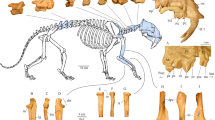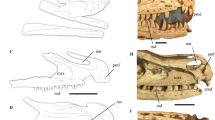Abstract
In 1925, when Dart described Australopithecus africanus1 as a hominid, critics interpreted it as a juvenile gorilla2,3,4. Last year, Wolpoff's colleagues (B.S. and M.P.) claimed that their Kenyan fossil Orrorin was a direct ancestor of Homo5, and now Wolpoff et al. conclude that Sahelanthropus was an ape (specifically, a female gorilla ancestor6) — a belief that, to our knowledge, is not supported by published or unpublished data.
Similar content being viewed by others
Brunet et al. reply
Overlooking their flippant taxonomic proposal (the genus name 'Sahelpithecus'), which disregards the requirement for a new genus to have a type species and description7, we disagree with their (presumably more serious) opinions on the morphology and phylogeny of the Toumaï fossil.
Because the Toumaï fossil is the earliest known hominid ancestor8, it is not surprising that it bears primitive characters. Following modern systematic practice, we used newly evolved characters (rather than shared primitive characters) to establish phylogenetic relationships8. Those who ignore these derived characters and concentrate on primitive ones will reach the conclusion that early hominids, including Orrorin, are related to modern apes. This has not been in dispute since Huxley and Darwin. For Wolpoff et al. to revert to the use of primitive characters in an attempt to undermine a clear statement of affinity of Toumaï is curious.
Wolpoff et al. make several erroneous assertions about the cranial face and base. For example, they mischaracterize the configuration of the face in S. tchadensis, claiming that supraorbital size is directly related to postcanine tooth size and/or to masticatory forces. However, experimental and developmental investigations9,10 have shown that strains caused by mastication in the brow ridge of orthognathic and prognathic primates are always tiny, much too small to engender bone-growth responses to loading. Instead, large brow ridges grow because of facial projection relative to the cranial base11.
Wolpoff et al. also obfuscate the facial similarities to Homo. We did not suggest that Homo erectus is 6–7 million years old — the point with Homo was comparative, rather than phylogenetic. Relying on measurements of our published photographs of the distorted original, Wolpoff et al. wrongly assert that the nuchal plane is angled at about 55° to the Frankfurt horizontal. Undistorted, the nuchal plane's angulation is outside the range of chimpanzees and within the range of fossil hominids12. This configuration is nothing like that of any quadrupedal ape, with or without a powerful masticatory complex (which Sahelantrophus lacks, contrary to the assertions of Wolpoff et al.).
These authors not only misrepresent the specimen's morphology, but also fail to identify a single character to support their suggestion that Toumaï is a gorilla rather than a hominid ancestor. They interpret our description of distal dentin exposure of the upper canine as evidence of honing wear (roughly equivalent to describing an African millet pestle as a Samurai sword). The Toumaï canine is not honing because it does not display the sharpened distal edge that is shared by all apes. Rather, this tooth is similar to those of later hominids in both size and proportion to the postcanine teeth.
In a modern example of how to miss the morphology between measuring points, Wolpoff et al. argue that the size of the Toumaï canine is ape-like. It is well known that early hominid and modern ape canine buccolingual diameters overlap in size. But, as Broom and Robinson13 noted in their assessment of Zuckerman's failed attempt to sideline Australopithecus 50 years ago: “If ... the affinities of an animal are to be determined by the size and indices of its teeth, and not by their structure, a horse may have to be put in the same group as a cow.” In its relative size, morphology and wear, the Toumaï canine is derived in the hominid direction relative to any ape.
This phylogenetic signal is significant. Ignoring it in favour of a belief based on Orrorin and primitive characters is unjustified, particularly as the phylogenetic position of the Orrorin fossils remains uncertain. Wolpoff et al. have described no derived ape feature of S. tchadensis, nor have they disproved any derived features that this species shares with later hominids8. Any alternative phylogenetic hypothesis should be based on explicit, supporting derived characters of Toumaï.
References
Dart, R. A. Nature 115, 195–199 (1925).
Keith, A. Nature 115, 234 (1925).
Duckworth, W. L. H. Nature 115, 236–237 (1925).
Keith, A. Nature 159, 377 (1947).
Senut, B. et al. C. R. Acad. Sci. Paris 332, 137–144 (2001).
Fléaux, R. Sci. Avenir Paris 666, 12 (2002).
International Commission on Zoological Nomenclature International Code of Zoological Nomenclature 4th edn (Int. Trust Zool. Nomenclature, London, 1999).
Brunet, M. et al. Nature 418, 145–151 (2002).
Hylander, W. L. & Johnson, K. R. in The Biological Mechanisms of Tooth Movement (ed. Davidovitch, Z.) 559–569 (Ohio State Univ. Coll. Dentistry, Columbus, 1992).
Ross, C. R. Am. J. Phys. Anthropol. 116, 108–139 (2001).
Lieberman, D. E. in Development, Growth and Evolution: Implications for the Study of the Hominid Skeleton (eds O'Higgins, P. & Cohn, M.) 86–122 (Academic, London, 2000).
Kimbel, W. H., White, T. D. & Johanson, D. C. Am. J. Phys. Anthropol. 64, 337–388 (1984).
Broom, R. & Robinson, J. T. Mem. Transvaal Mus. 6 (1952).
Author information
Authors and Affiliations
Corresponding author
Additional information
brief communications is intended to provide a forum for both brief, topical reports of general scientific interest and technical discussion of recently published material of particular interest to non-specialist readers. Priority will be given to contributions that have fewer than 500 words, 10 references and only one figure. Detailed guidelines are available on Nature's website (http://www.nature.com) or on request from nature@nature.com
Rights and permissions
About this article
Cite this article
Brunet, M. Sahelanthropus or 'Sahelpithecus'?. Nature 419, 582 (2002). https://doi.org/10.1038/419582a
Issue Date:
DOI: https://doi.org/10.1038/419582a
This article is cited by
-
New material of the earliest hominid from the Upper Miocene of Chad
Nature (2005)
-
Skull draws daggers
Nature (2002)
Comments
By submitting a comment you agree to abide by our Terms and Community Guidelines. If you find something abusive or that does not comply with our terms or guidelines please flag it as inappropriate.



